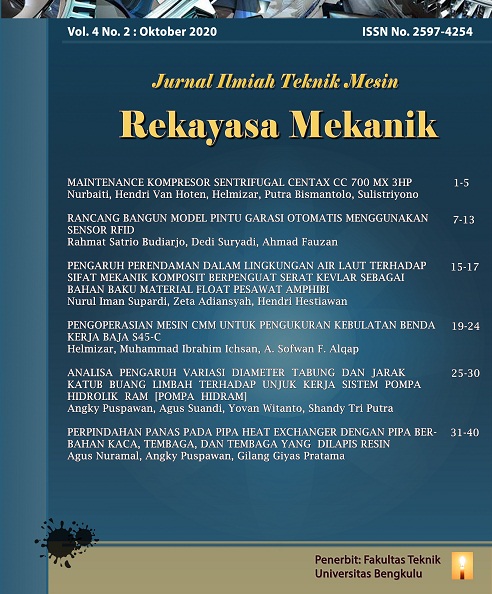Main Article Content
Abstract
Kevlar fibers have several advantages compared to other synthetic fibers, such as high tensile strength and relatively low density because it is composed of hydrogen bonds. This study aims to compare the mechanical strength of Kevlar fiber reinforced composites before and after immersion in a seawater environment as raw material for amphibious aircraft float materials. The materials used in this research consist of kevlar fiber, vinylester resin and methyl ethyl ketone peroxide catalyst. Composites manufactured by the vacuum infusion technique. The fibers were arranged in a mold, then a vacuum process was carried out to attract the resin stream. Tensile and shear tests were carried out before and after immersing the composites in a sea water environment at room temperature for 264 hours. Tensile test specimens refer to the ASTM standard of D3039, while the shear test specimens refer to the ASTM standard of D5379. The tensile strength of the kevlar fiber reinforced composites before immersion is 421.2 MPa. After immersion in a seawater environment, the tensile strength of the composite decreased to 389.3 MPa or decreased by 7.5%. Meanwhile, the shear strength of Kevlar fiber reinforced composites after immersing in a sea water environment did not change significantly from 14.6 MPa to 14.46 MPa or a decrease of 1.6%.
Keywords
Article Details
References
- ASTM D 3039. 2002. “Standard Test Method for
- Tensile Properties of Polymer Matrix
- Composite Materials”. ASTM International,
- Barr Harbor Drive, P.O. Box C700,
- West Conshohocken, PA 19428-2959, USA.
- ASTM D5379. “Standard Test Method for Shear
- Properties of Composite Materials by the VNotched
- Beam Method”. ASTM
- International, 100 Barr Harbor Drive, P.O.
- Box C700, West Conshohocken, PA 194282959,
- USA.
- Connor, C dan Chadwick M. M. 1996.
- “Characterization of absorbed water in
- aramid fibre by nuclear magnetic reso-
- nance”. Journal of Materials Science, Vol.
- , 3871–3877.
- Kwolek, S., Mera, H. dan Takata, T. 2002. “High-
- Performance Fibers” dalam ullmann’s
- Encyclopedia of Industrial Chemistry,
- Wiley-VCH Weinheim.
- Sehri, M.S. 2015. “Analisis sifat mekanik komposit
- karbon UD0
- dan E glass WR 185
- menggunakan matrix epoxy dengan metode
- vacuum infusion”. Yogyakarta: STTA.
- William. J. C. dan Starke Jr., E. A. 2003. “Progress
- in Structural Materials for Aerospace
- System”. Acta Materialia. Vol. 51. 57755799.
References
ASTM D 3039. 2002. “Standard Test Method for
Tensile Properties of Polymer Matrix
Composite Materials”. ASTM International,
Barr Harbor Drive, P.O. Box C700,
West Conshohocken, PA 19428-2959, USA.
ASTM D5379. “Standard Test Method for Shear
Properties of Composite Materials by the VNotched
Beam Method”. ASTM
International, 100 Barr Harbor Drive, P.O.
Box C700, West Conshohocken, PA 194282959,
USA.
Connor, C dan Chadwick M. M. 1996.
“Characterization of absorbed water in
aramid fibre by nuclear magnetic reso-
nance”. Journal of Materials Science, Vol.
, 3871–3877.
Kwolek, S., Mera, H. dan Takata, T. 2002. “High-
Performance Fibers” dalam ullmann’s
Encyclopedia of Industrial Chemistry,
Wiley-VCH Weinheim.
Sehri, M.S. 2015. “Analisis sifat mekanik komposit
karbon UD0
dan E glass WR 185
menggunakan matrix epoxy dengan metode
vacuum infusion”. Yogyakarta: STTA.
William. J. C. dan Starke Jr., E. A. 2003. “Progress
in Structural Materials for Aerospace
System”. Acta Materialia. Vol. 51. 57755799.

